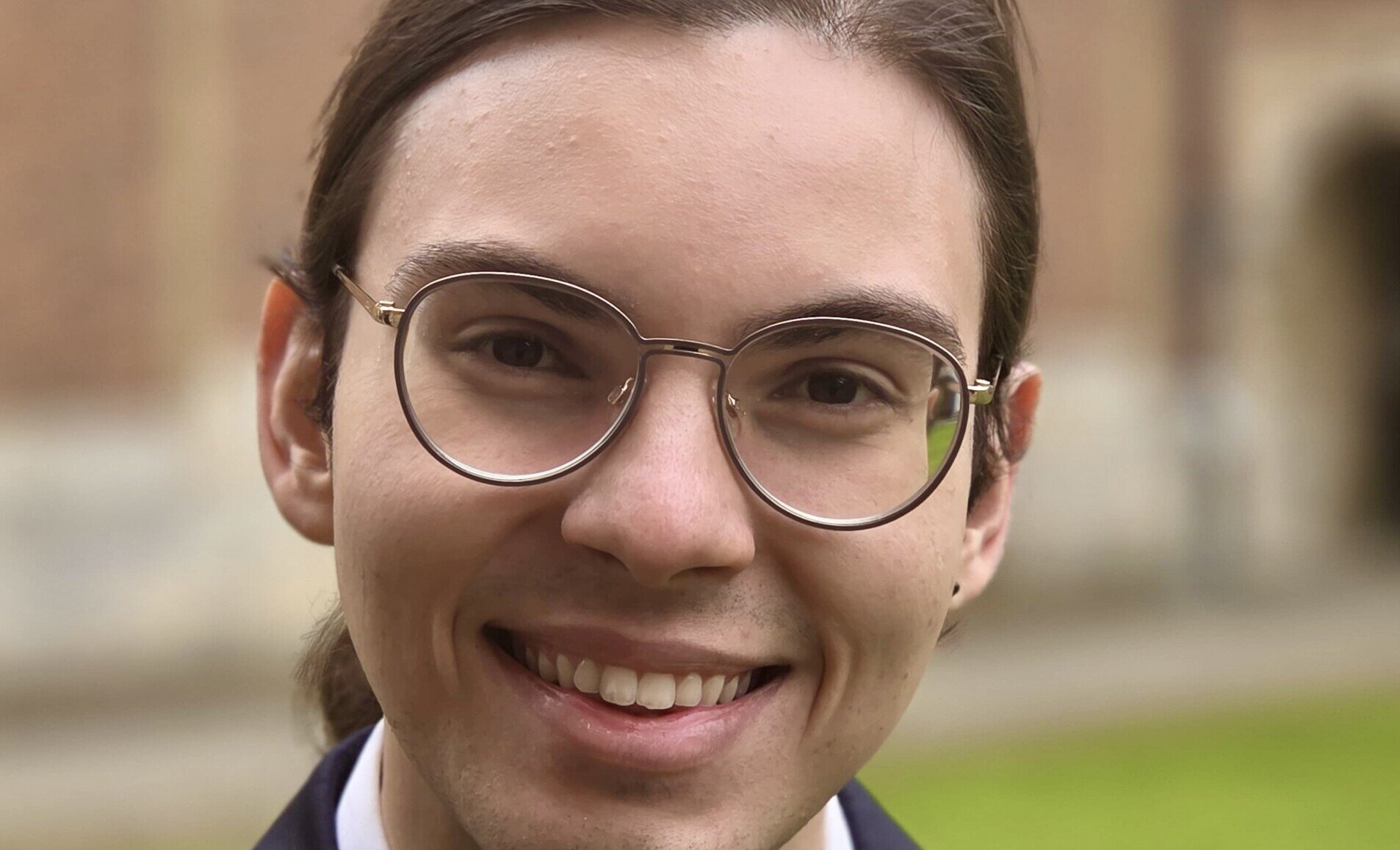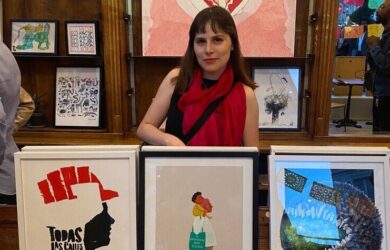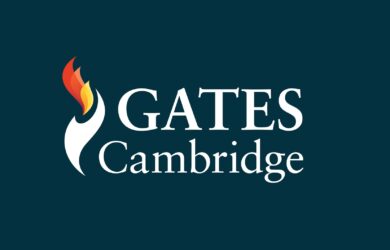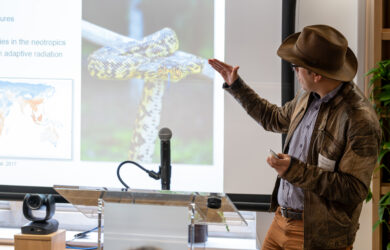
Marcelo Mesa Costa Lima's PhD will explore the largest enzyme in the mitochondrial respiratory chain - the process of how the body extracts energy from food.
We know that free energy is extracted to make ATP by the action of the respiratory complexes and ATP synthase, but we don’t know how some of these complexes actually work at the molecular level. It’s a mystery.
Marcelo Mesa Costa Lima [2025] is interested in one of the fundamental questions of science – what gives us life. His PhD, which follows on from previous research experience working with mitochondria and a deep interest in the process of how the body extracts free energy from food, is focused on Complex I, the largest enzyme in the mitochondrial respiratory chain which plays a crucial role in the process of oxidative phosphorylation.
This process is the final, energy-intensive stage of aerobic respiration where cells regenerate most of their ATP – the main molecule that carries and supplies free energy for cellular processes in living organisms. They do so by using electrons extracted from food and transferred to oxygen to power a series of protein complexes, known as the electron transport chain.
Marcelo describes the process as analogous to a pathway from photosynthesis called photophosphorylation, with food being substituted in humans for water and sunlight in plants.
His passion for his subject is clear when he speaks about how he evolved from wanting to be a doctor to becoming a scientist. His dream is to lead his own laboratory where he hopes to bring together photosynthesis and respiration to understand life’s driving force.
Childhood
Marcelo was born and grew up in Sao Paulo, Brazil. He comes from a fairly medical family – although his father is an economist, his mother is a doctor and his younger sister is studying medicine in Florence, Italy. Marcelo himself considered becoming a doctor, inspired by his mother, before finding that he was more interested in the biological sciences and understanding that he could help others just as much through research – if not more – than through being a doctor.
“When I was younger I felt that being able to save a person’s life was so beautiful, but I realised over time that what I really wanted to do was to study the very basic questions of biological sciences so I could help people in other ways and that there is more than one way to improve the lives of others,” he says.
Marcelo attended the same school, close to home, for most of his early life and says his chemistry teacher at secondary school inspired him to look outside medicine at other sciences. Aside from science he loved history, singing and art. The Italian Renaissance was his passion, and he learned to draw with his uncle whom he spent a lot of time with and who shared his passion for wildlife and science. “He was the first person who talked to me about the concept of atoms,” he says.
Marcelo describes himself as being very introverted as a teenager and says he only came out of his shell once he reached university. When he finished school, he was still considering a career in medicine. He had never heard of anyone close to him who was a professional scientist. He applied to study medicine, but when he sat the entrance exams he was suffering from depression. His mental health got worse in between school and university, and he took some time out to recover. In 2019, he was accepted onto the Biological Sciences course at the University of Sao Paulo.
University
Marcelo began his undergraduate studies at the University of Sao Paulo [USP] in February 2020, just a few weeks before the Covid lockdown. He describes the experience of starting university and imagining himself as a scientist as ‘life-changing’. At first, he wanted to study coral reefs and work on conservation, but just before his university locked down for Covid, he attended an online lecture about the origins of life and how life functions, drawing on thermodynamics, which totally captivated him. Marcelo had long been curious about the meaning of life and indeed those questions fed his depression to some degree. He was never happy with the answers he received. “They were never enough. Then, I realised I could use science to understand the mechanisms that allow living things to exist,” he says.
By 2021, after months of studying online and after various exchanges with the astrobiologist Professor Fabio Rodrigues about how life originated and how it maintains itself, Marcelo had switched over from Biological to Molecular Sciences on the professor’s advice. The Molecular Sciences course was only open to existing students at the University of Sao Paulo who had to sit a special exam. They came from a wide range of specialisms, from History to Computer Science and Biology. After transferring, Marcelo had two years of challenging lectures in Physics, Chemistry, Biology, Maths and Computer Science, where he studied topics such as DNA replication, molecular orbitals and quantum mechanics, followed by two years in the laboratory doing research in his chosen field. There was no other course at USP at the time that allowed undergraduates to dedicate such an extensive two-year period doing research.
As part of his course, Marcelo did some Biochemistry classes with Professor Alicia Kowaltowski who was working on mitochondrial metabolism. “The lectures were amazing, the most brilliant classes I have attended in my life,” he says. “She explained metabolism in a very mechanistic way, and it taught us about the mechanistic process of life. By understanding metabolism, we could understand how life functions.”
He was particularly fascinated by oxidative phosphorylation, Peter Mitchell’s chemiosmotic theory and the role of the electron transport chain in maintaining organisms out of thermodynamic equilibrium, a state that is essential for life.
Early research
Professor Kowaltowski was unable to take on any more research students at that time so she recommended Professor Mario Barros who also works with mitochondria. He suggested that Marcelo work on proteins of unknown function that could be linked to the assembly of the electron transport chain molecular complexes within the inner mitochondrial membrane. The assembly pathway is a complex process guided by numerous assembly factors and requires the convergence of intermediate protein modules to make a functional electron transport chain. Professor Barros gave Marcelo a list of the proteins that were likely involved in this process, but whose function is unknown and told him to choose one. He chose Mrx3, a component of the MIOREX complexes in yeast, which are likely to be involved with mitochondrial gene expression. The work taught him how to work with yeast, which is easy to manipulate for the purposes of research.
Marcelo is profoundly grateful to Professor Barros and says simply: “He made me a scientist. We had amazing talks about life and mitochondria’s role.” By late 2023 Marcelo was working as an undergraduate research student in Professor Barros’ laboratory every day and that work continued until early 2025 when he graduated.
Outreach work
Enthused by his love of science, Marcelo also became involved in outreach work at the university. He twice represented the Molecular Sciences course in USP’s Careers Fair, answering questions from students from across Brazil about higher education, Molecular Sciences and USP.
He was also nominated by the Dean of Molecular Sciences to visit the MIT Brazil Programme from MISTI [MIT International Science and Technology Initiatives] in the US in October 2023 as an ambassador student as part of its outreach work to high school students in Brazil. In January 2023, MIT Brazil collaborated with USP’s Molecular Sciences department to launch the first one-week Global Teaching Labs workshop called Polymers of Soccer. This enabled MIT and USP undergraduates to interact and teach Brazilian high school students about materials science in the context of soccer, such as investigating the science behind the fabrics and footballs used in the sport. Marcelo participated in activities designed to encourage internships in Brazil and meetings to improve the Polymers of Soccer programme when he was at MIT. In January 2024, he participated in the workshop as an instructor coordinating the USP team.
Also in 2024 Marcelo, who was also working as a teaching assistant in biochemistry for the Molecular Sciences course, took part in iGEM, an international biological research competition. As a main goal, his team was aiming to produce a protein that can be used to treat patients with Gaucher’s disease – a rare, inherited genetic disorder that causes a build-up of fatty substances in the body’s cells. To function properly the protein needs to undergo glycosylation – the process of attaching carbohydrate molecules to other molecules. Having worked previously with yeast and knowing its flexibility, Marcelo worked with it to coordinate the engineering of a modified glycosylation pathway for the production of the enzyme glucocerebrosidase. “I got into the team because of my experience with yeast and it was an amazing opportunity,” he says.
PhD
Marcelo had been considering postgraduate studies since he first realised he wanted to become a scientist. Professor Kowaltowski mentioned that the Nobel Laureate John Walker, the professor whose work on ATP synthase is world renowned, was based at the University of Cambridge. Marcelo knew that Cambridge is also home to the MRC Mitochondrial Biology Unit – a whole unit dedicated to mitochondria. “There is nowhere else in the world that has a dedicated unit like that, and I realised it was the best place for me to work with scientists working on different aspects of mitochondria,” he says.
He began his PhD in Medical Sciences in October under the supervision of Professor Judy Hirst. He is working on mitochondrial complex I, also known as NADH:ubiquinone oxidoreductase. It is the largest enzyme in the mitochondrial respiratory chain and plays a vital early role in the process of oxidative phosphorylation, which generates the majority of cellular ATP. “We know that free energy is extracted to make ATP by the action of the respiratory complexes and ATP synthase, but we don’t know how some of these complexes actually work at the molecular level”, he says. “It’s a mystery.”
He will be working with bacteria, given that they also have complex I and are simpler and easier to manipulate than human mitochondria.
Marcelo only found out about Gates Cambridge when he applied for his PhD and sent his research proposal to Professor Hirst. His referee was Professor Marie-Anne Van Sluys who had suggested the lecture on the origins of life that so inspired Marcelo when he started at USP. “I will be forever grateful to her,” he says. “Cambridge and Gates Cambridge are the opportunity of a lifetime.”












